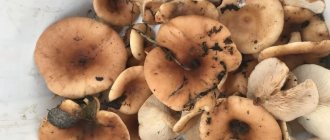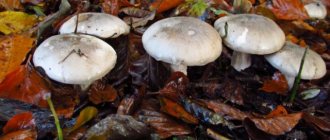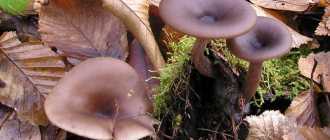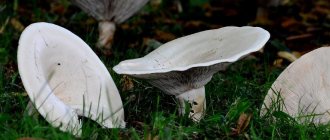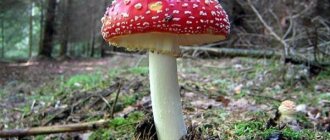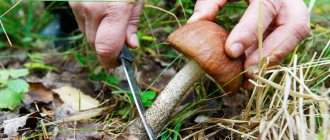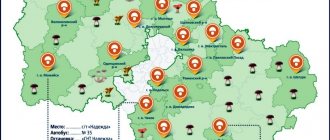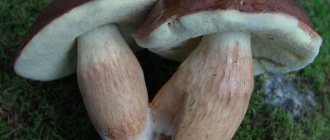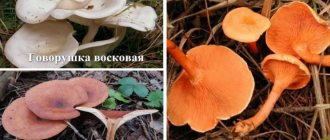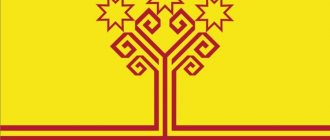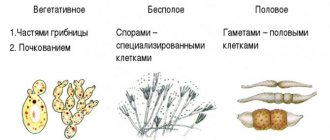Goblet talker Pseudoclitocybe cyathiformis
A mushroom from the genus Pseudogovorushka, family Ordinaceae, also known as Pseudogovorushka goblet.
Appearance
The cap is up to 8 cm in diameter, has the shape of a deep funnel, with an uneven curved edge, and is painted in grayish-brown shades. In dry weather the cap is silky to the touch; in rainy weather it becomes slimy.
The hymenophore is lamellar, the plates are sparse and descending, colored in grayish-brownish shades, lighter than the caps. Spore powder is light.
The leg is up to 7 cm long and up to 0.5 cm in diameter, thin and hollow, with a pubescent base, slightly lighter in color than the cap.
The pulp is watery and thin, grayish-brown in color.
Where and when does it grow
Grows from early August to late September in mixed and coniferous forests. Lives on rotting wood and forest floor, in groups and alone. Occurs relatively infrequently.
External resemblance
In shape, this species is very similar to the funnel talker, but is easily distinguishable from it by its color, grayish flesh and thinner stem.
Culinary use
The mushroom is edible and suitable for most types of cooking after boiling for 15 minutes.
Whitish Talker Clitocybe rivulosa
A mushroom from the genus Govorushka, family Oryadovaceae, also known as Govorushka Bleached, Reddish or Discolored. Deadly poisonous mushroom.
Appearance
The cap is up to 6 cm in diameter, initially convex, with a rolled edge, then spread out, flat and slightly depressed with a wavy edge. The color of the cap varies from powdery white to ocher. In older specimens, small grayish spots are found on its surface.
The cap is covered with a powdery coating, which is easily removed; in damp weather, mucus appears on it; when it dries, it becomes silky and shiny, and when completely dry, it cracks.
The hymenophore is lamellar, the plates are frequent, descending onto the stalk, initially whitish, later light yellow. Spore powder is white.
The stalk is longitudinally fibrous, up to 4 cm long and up to 0.6 cm thick, cylindrical, with a slight narrowing towards the base, becoming hollow over time. The color of the leg is whitish-gray, in places with nut-colored spots, and darkens when pressed.
The pulp is fibrous and elastic, white and does not change color when cut, has a mealy odor and a weak taste.
Where and when does it grow
It grows from mid-July to November in pastures and meadows, in parks, on the edges of deciduous and mixed forests, in places with abundant grass cover, on soil or forest floor. The fruiting bodies often grow in large groups or in witch circles.
Similar view
There is a variety of White Talker, called Clitocybe dealbata in Latin, which has grayish plates and a slightly longer stalk. However, molecular studies do not allow these two varieties to be divided into two separate species, and their degree of toxicity is exactly the same.
Danger level
Govorushka Belovataya contains a high concentration of muscarine, which rarely causes death when consumed by humans, but can cause severe food poisoning, which manifests itself within 15 minutes after eating the mushroom and is characterized by increased salivation and sweating, a sharp decrease in blood pressure, a decrease in heart rate, and impaired breathing and severe gastrointestinal distress.
Muscarine poisoning is treated with the use of atropine and other M-anticholinergic drugs.
Is it possible to grow this type of mushroom yourself?
This is an unassuming mushroom. Therefore, they are grown in open ground in an area with young trees. Quite quickly, mushrooms form mycorrhiza with them.
The mycelium is planted in late spring - early summer, when the time of frost has passed. Three holes are dug near each tree - 20 cm deep and 15 cm in diameter. They are filled halfway with soil; you can use universal soil for indoor plants, which you can purchase in the store. The mycelium is distributed evenly over the soil and covered with soil, compacted well. The top of the holes is covered with pine needles, twigs, and leaves. Carefully water the plantings with water.
However, the first harvest will be enjoyed only after a year; the mycelium bears fruit in one place for up to 5 years.
Govorushki is a tasty and healthy mushroom with a strong, pleasant aroma. But due to its poisonous counterparts, it is rarely collected and used for food and stored for future use. In addition, the fungus plays a huge role in the life of the forest, actively participating in the process of humus formation.
0
1
Copy link
Talker Anise Clitocybe Odora
A mushroom from the genus Govorushka, family Ordinaceae, also known as Govorushka Odorous and Govorushka Fragrant.
Appearance
The cap is up to 10 cm in diameter, initially convex in shape, with a rolled edge, later spread out or concave. The color of the cap varies from bluish-green in youth to yellow-gray in mature fruiting bodies.
The hymenophore is lamellar, the plates are descending and frequent, colored in pale greenish shades. Spore powder is white.
The leg is up to 8 cm long and up to 1 cm thick, with a thickening at the base, colored slightly lighter than the cap.
The pulp is thin, pale gray or pale green in color, with a weakly expressed taste and a very characteristic, strong dill-anise smell. You just need to go out into a clearing with anise talkers to smell this aroma.
Culinary use
The mushroom is edible and suitable for various types of culinary processing, but due to its specific smell, which persists even after boiling, it is not particularly popular.
Chemical composition
The chemical composition of the folded talker is varied. It includes a whole complex of vitamins, minerals and other biologically active components that have a positive effect on the body.
In particular, there are substances such as:
- B vitamins (B1–B9) - enhance the immune system, improve skin condition;
- vitamin D - gives vital energy, relieves depression and sleep disorders;
- betaine - cleanses blood vessels, stabilizes the gastrointestinal tract, helps the absorption of many vitamins and minerals;
- selenium - reduces the likelihood of cancer, helps normal cell growth and development;
- copper - participates in the synthesis of hemoglobin, has an anti-inflammatory effect;
- iron - ensures normal functioning of the thyroid gland, promotes the formation of hemoglobin;
- zinc - improves digestion, is responsible for cell growth, strengthens the immune system;
- potassium - normalizes blood pressure, improves the density of muscle and bone tissue;
- phosphorus - promotes mental and muscle activity, maintains the normal condition of bones and teeth;
- sodium - normalizes water-salt metabolism, participates in the production of gastric juice;
- magnesium - participates in the transmission of neuromuscular impulses and energy production by the body;
- calcium - is responsible for the formation of the skeleton, participates in metabolic processes, and regulates healthy hormonal levels.
Talker Fragrant Clitocybe Fragrans
A mushroom from the genus Govorushka, family Oryadovaceae.
Appearance
The cap is up to 6 cm in diameter, initially convex, later concave in shape with a drooping, sometimes wavy edge, painted in yellowish-gray or pale ocher tones.
The hymenophore is lamellar, the plates are descending and narrow, white, darkening with time. Spore powder is white.
The leg is up to 5 cm long and up to 1 cm in diameter, solid and cylindrical, with slight pubescence at the base, painted in yellowish-gray tones.
The pulp is brittle, thin and watery, light, with a weak taste and anise smell.
Where and when does it grow
It grows in groups from late August to October in coniferous and mixed forests. Very rare.
Culinary use
Conventionally, it is an edible mushroom that requires boiling before use. Recommended for consumption in pickled form.
Talker Clubfoot Ampulloclitocybe Clavipes
A mushroom from the genus Ampuloclitocyb, family Hygrophoraceae.
Appearance
The cap is up to 8 cm in diameter, initially convex, later spread out, sometimes with a tubercle in the center, colored in gray-brownish shades.
The hymenophore is lamellar, the plates strongly descend along the stalk, of medium frequency and white in color, darkening over time to cream. Spore powder is white.
The leg is up to 9 cm high and up to 3.5 cm in diameter, club-shaped, with pubescence at the base. The color of the leg changes with age from white to whitish-gray.
The pulp is whitish and loose, strongly hygrophanous in damp weather, with a sweetish odor and a weakly expressed taste.
Where and when does it grow
It grows from mid-July to the second half of October in forests of different types, forming mycorrhiza with both coniferous (pine) and deciduous (birch) trees. Found in numerous groups.
Culinary use
Conventionally, it is an edible mushroom that requires preliminary boiling before consumption and does not have any special gastronomic properties.
Collection rules
The bent talker is included in the Red Book of Russia, so when you see it in the forest, you should not rush to collect it. In European countries, where it is more common, it is harvested during the fruiting season.
Like other edible mushrooms, it is better not to cut the red talker above the soil surface, but to twist it out of the mycelium. The tearing area should be lightly sprinkled with earth. This method of collecting will allow you to preserve the mycelium, it will not rot, and will be able to bear fruit for many years to come.
Advice! Inedible legs can be cut off with a sharp knife after collecting directly in the forest, so as not to carry excess weight home.
Young Clitocybes are more suitable for food; older specimens may have a pungent, unpleasant odor.
Giant Talker Leucopaxillus Giganteus
Mushroom from the genus Belosvinukha, family Oryadovaceae.
Appearance
The cap is up to 30 cm in diameter, slightly funnel-shaped, with a lobed-wavy edge, painted in whitish-gray shades.
The hymenophore is lamellar, the plates are white, darkening to cream with age. Spore powder is white.
The leg is up to 6 cm high and up to 3 cm in diameter, monochromatic with a cap, dry and fibrous.
The pulp is thick and white, without a distinct taste and with a powdery odor.
Where and when does it grow
It grows from July to October in clearings in forests of various types, found in groups and “witch rings”.
Culinary use
Conventionally, it is an edible mushroom, suitable for food after boiling for half an hour. Contains a natural antibiotic that destroys the tuberculosis bacillus, but does not have any special gastronomic properties.
Symptoms of poisoning
Harmful substances that enter the body along with mushrooms can accumulate for 2 - 3 hours before the first signs of poisoning appear.
Poisonous mushrooms cause a reaction within 20 minutes. after reception. This is due to the increased content of poison. However, the inverted talker contains less dangerous toxins: their influence does not give an immediate result.
After taking it, the first symptoms begin to appear, which may not be immediately noticeable:
- slight dizziness;
- slight decrease in blood pressure;
- drowsiness;
- decreased muscle tone.
After a few hours, serious symptoms are added to the mild symptoms:
- nausea with increasing vomiting;
- diarrhea;
- sharp pain in the upper part of the stomach;
- change in skin tone;
- sweating;
- salivation;
- tachycardia;
- pressure surges.
Vomiting and diarrhea can lead to dehydration, which entails accompanying symptoms: severe drowsiness, decreased coordination, fever, general weakness, blurred vision.
Winter Talker Clitocybe Brumalis
A mushroom from the genus Govorushka, family Oryadovaceae.
Appearance
The cap is up to 5 cm in diameter, initially convex, then prostrate, with thin sinuous edges. The color of the cap varies from smoky to whitish-brown.
The hymenophore is lamellar, the plates are descending, narrow and frequent, yellow-gray in color. Spore powder is white.
The stem is up to 4 cm high and up to 0.6 cm in diameter, cylindrical, longitudinally fibrous and hollow, slightly lighter in color than the cap.
The pulp is thin and elastic, white, with a floury smell and taste.
Where and when does it grow
It grows from August to November on the forest floor in coniferous forests.
Culinary use
Conventionally, it is an edible mushroom, suitable for food after a short boiling, used in soups and main courses, dried and salted.
Useful properties and restrictions on the use of talkers
Talkers are rich in vitamins, minerals, and amino acids. They have a good effect on the digestive system and strengthen the immune system. Very often, talkers are used as part of a diet, as they are low in calories.
This variety is used to remove waste, toxins and metal salts from the body. They also lower cholesterol levels, which reduces the likelihood of blood clots.
It is contraindicated to eat inedible and poisonous varieties, as this leads to severe poisoning and intoxication of the body. Mushrooms should not be consumed by children under 12 years of age, people with gastrointestinal diseases, and with caution by pregnant and lactating women.
Treatment
You can only eat those types of talkers that are included in the list of edibles. Before use, mushrooms are washed, peeled, and heat treated. To do this, they are placed in a pan of boiling water for 30-40 minutes. The resulting decoction is not used. After this, the mushrooms are suitable for further cooking.
Recipes
To prepare fried talkers, pre-boiled mushrooms are placed in a heated frying pan. During cooking, add chopped onion, salt and pepper to the dish. At the end you can add sour cream. Serve the dish warm, sprinkled with fresh herbs.
Fried talkers
Experienced housewives recommend baking talkers along with meat and potatoes. To do this, you need to prepare and chop the mushrooms and place them on a baking sheet. Place meat and potatoes on top and sprinkle with spices. Govorushki can be served not only as an independent treat, but also added to first and second courses.
Orange Talker Hygrophoropsis Aurantiaca
A mushroom from the genus Hygrophoropsis, family Hygrophoropsis, also known as False Chanterelle.
Appearance
The cap is up to 10 cm in diameter, initially convex, then prostrate or funnel-shaped, with a thin, curved, wavy edge. The cap is colored in yellow-orange shades, with a darker center, the edge can fade to white.
The hymenophore is lamellar, the plates are strongly descending, thick and frequent, with branches, colored yellow-orange and turn brown when pressed. Spore powder is white.
The leg is up to 6 cm long and up to 1 cm in diameter, cylindrical, becomes hollow over time and can be curved at the base. The leg is colored in yellow-orange shades and is usually brighter than the cap.
The pulp is dense, reddish-orange, with a faint smell and taste.
Where and when does it grow
Grows from early August to late October in coniferous and mixed forests, on forest floor, soil or rotting wood. Occurs singly or in large groups.
I!
The mushroom is officially classified as mildly poisonous and can cause moderate food poisoning.
First aid for poisoning
An inverted talker can cause severe poisoning due to the content of a complex of toxic substances. If you discover accidental use of this mushroom, you must call an ambulance.
Before the team of specialists arrives, it is first of all important to eliminate the influence of toxins and prevent dehydration after vomiting and diarrhea. To this end, the necessary measures will be:
- drinking fluids to prevent dehydration (preparing a saline solution at the rate of 1 teaspoon per 1 cup of water or using pharmaceutical products: Regidron and analogues);
- the use of enterosorbents to remove harmful substances (Enterosgel, Polysorb suspension solution, activated carbon);
- if the temperature rises, take antipyretics (Paracetomol, Ibuprofen);
- the victim should be in bed, with warm heating pads placed on his legs and stomach.
In some cases, diarrhea and vomiting may be absent, which makes it difficult to diagnose poisoning and entails serious consequences, since toxins do not leave the body. First aid includes artificially inducing vomiting. To do this, drink 1.5 liters of potassium permanganate solution, then press on the root of the tongue.
Talker Red – Brown Paralepista Flaccida
A mushroom from the genus Paralepista, family Oryadovaceae, also known as Govorushka Rajaya.
Appearance
The cap is up to 14 cm in diameter, initially convex, then prostrate, with a wavy edge and indentations similar to the spout of a jug.
The hat is painted in brick-orange shades, turning pale as it dries.
The hymenophore is lamellar, the plates are narrow and frequent, descending, initially white, then gradually darken to pinkish-brown. Spore powder is creamy.
The stem is up to 10 cm high and up to 1.5 cm in diameter, cylindrical, slightly lighter in color than the cap and slightly pubescent at the base.
The pulp is thin, light, without a pronounced taste and has a sweetish odor.
Where and when does it grow
It grows from late August to early winter in coniferous and mixed forests, usually in dense groups.
Benefits of mushroom
Talkers are quite useful mushrooms. They have the following qualities:
- increase human immunity;
- have a beneficial effect on the digestive system, as they contain components for enzymes. However, you should not get carried away with mushroom dishes;
- used in the treatment of diseases of the respiratory system and bladder;
- destroy cholesterol plaques;
- antibacterial ointments are prepared from them, which are used to lubricate wounds;
- the caps of young representatives are rich in numerous micro- and macroelements;
- the pulp helps remove accumulated toxins;
- A decoction of talkers is used to relieve the manifestations of tuberculosis.
